
The integration of Relational AI and Digital Twins is revolutionizing industries by unlocking smarter, faster, and more scalable real-time simulations. This innovative synergy enables businesses to model, predict, and optimize processes with unprecedented accuracy.
Here we’ll explore how these cutting-edge technologies combine to transform simulation capabilities, decision-making, and operational efficiency.
What Is Relational AI? The Foundation for Smarter Simulations
The Power of Relational Data Modeling
Relational AI leverages relational database systems to model complex relationships and dependencies within data. Unlike traditional AI systems, which often focus on unstructured data, Relational AI excels in processing highly structured, interconnected datasets.
For real-time simulations, this approach creates a dynamic and scalable framework to link multiple variables and systems. Think of it as building the “brain” for your Digital Twin.
Why Relational AI Is Crucial for Real-Time Processing
Real-time simulations demand rapid data ingestion and decision-making. Relational AI:
- Processes real-time inputs from multiple sources.
- Ensures simulations adjust dynamically to new information.
- Reduces errors by maintaining data consistency across systems.
By improving efficiency and accuracy, Relational AI lays the groundwork for simulations that are as close to reality as possible.
Digital Twins: The Living Digital Replica

What Are Digital Twins?
Digital Twins are virtual models of physical objects or systems, designed to mirror their real-world counterparts. By collecting real-time data, these replicas enable businesses to analyze, monitor, and optimize processes.
For instance:
- A manufacturing plant‘s Digital Twin monitors performance, predicting equipment failures before they occur.
- In smart cities, Digital Twins simulate traffic flows to improve urban planning.
Real-Time Benefits of Digital Twins
- Enhanced Monitoring: Continuous updates keep simulations relevant.
- Predictive Insights: AI-driven analysis identifies trends and outcomes before they happen.
- Operational Savings: Optimizations reduce costs and improve productivity.
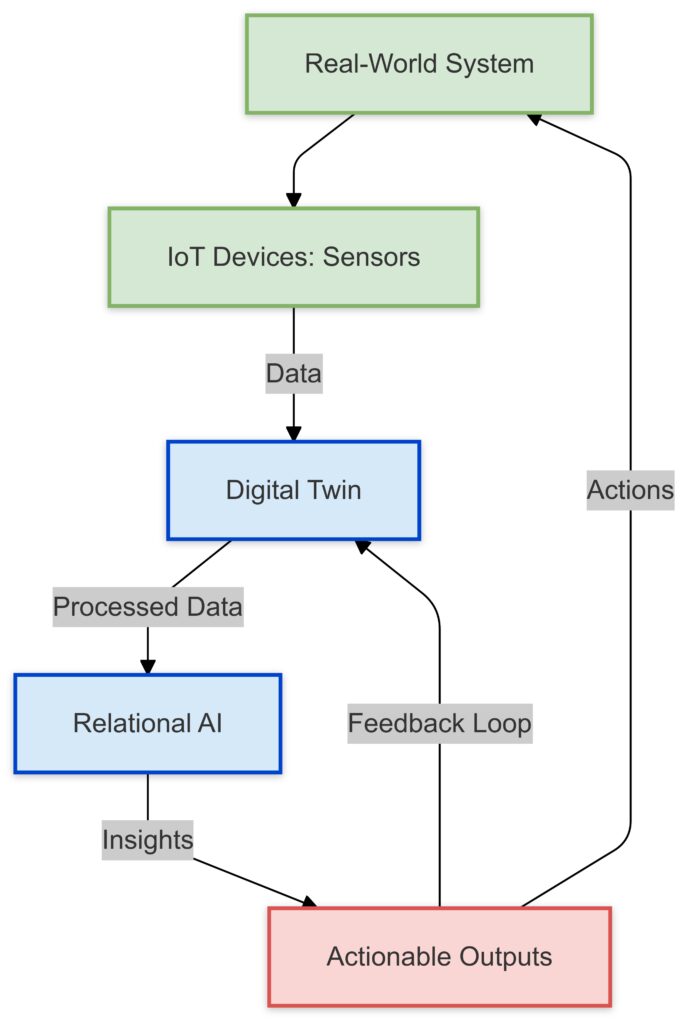
Real-time data from sensors flows into the Digital Twin, where Relational AI processes the information and delivers actionable insights.
However, the true magic happens when Digital Twins integrate with Relational AI.
How Relational AI Supercharges Digital Twins
Seamless Integration of Complex Data
Relational AI enables Digital Twins to simulate multifaceted environments by efficiently handling:
- IoT sensor inputs.
- Geospatial data.
- Historical patterns.
This integration ensures Digital Twins are constantly learning, adapting to real-world changes.
Scenario Planning and Optimization
With Relational AI, businesses can simulate “what-if” scenarios in real-time. For example:
- A power grid Digital Twin can model responses to extreme weather, ensuring reliable service.
- Supply chains can adapt instantly to delays or demand fluctuations.
The result? Faster, smarter decisions that reduce downtime and enhance resilience.
Real-World Applications: Industries Leading the Charge
Healthcare: Improving Patient Outcomes
Hospitals use Digital Twins to model patient care pathways. Relational AI ensures these models adapt to real-time clinical data, optimizing treatment strategies.
Transportation: Revolutionizing Logistics
Relational AI-powered Digital Twins analyze real-time traffic patterns, enhancing routing efficiency and delivery times for logistics companies.
Manufacturing: Preventing Downtime
In factories, these technologies predict equipment failure with astounding accuracy, ensuring uninterrupted production lines.
Scaling Simulations: From Local to Global Systems
How Relational AI Handles Complexity at Scale
As simulations grow larger, managing interconnected systems becomes a monumental task. Relational AI excels at scaling by:
- Organizing and querying vast datasets efficiently.
- Supporting distributed systems with consistent performance.
- Integrating diverse data sources seamlessly.
For global enterprises, this means the ability to create Digital Twins for entire supply chains, smart cities, or ecosystems.
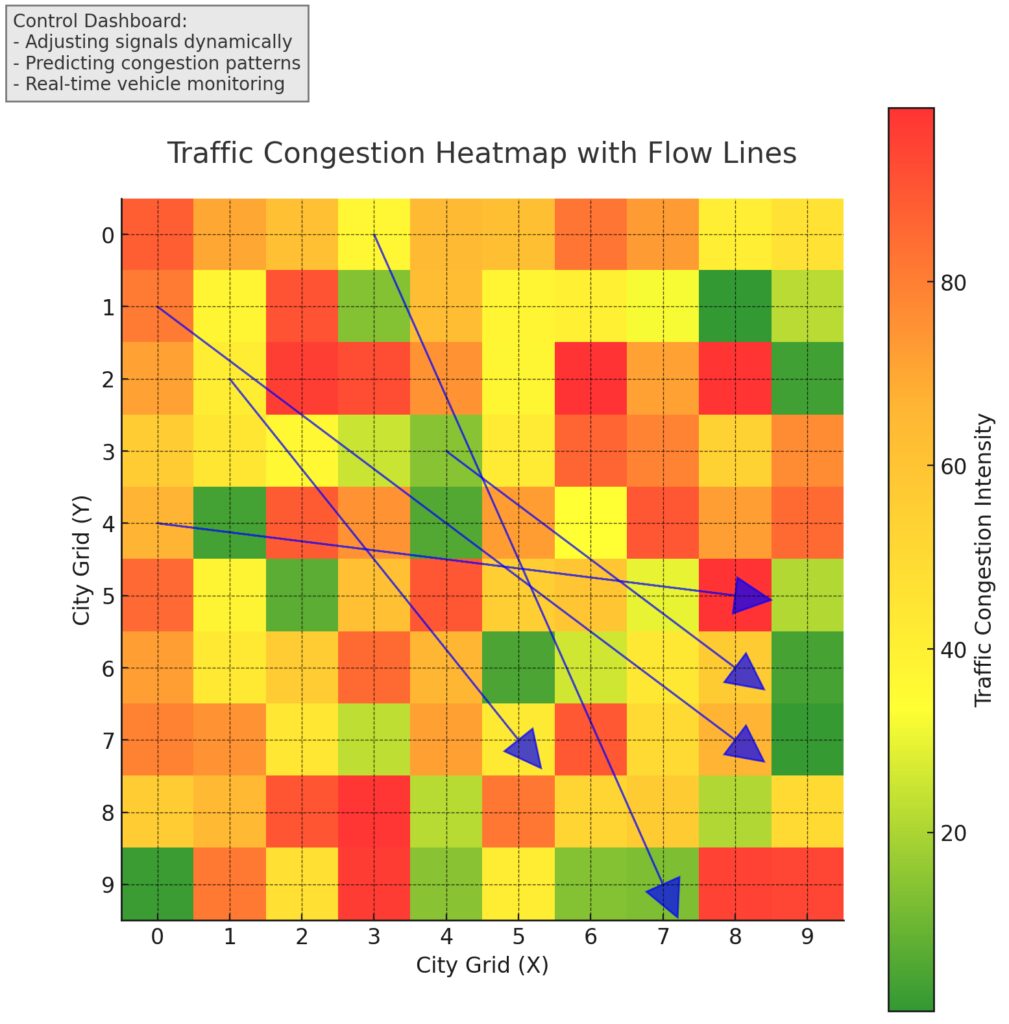
Key Features:
Heatmap:
Represents congestion intensity using a gradient from green (low) to red (high).
Congestion data is based on simulated real-time sensor inputs.
Flow Lines:
Blue arrows illustrate vehicle movement patterns across the city grid.
Indicate directions and pathways of traffic flow.
Control Dashboard:
Simulated annotations highlight dynamic signal adjustments, traffic predictions, and vehicle monitoring.
Serves as a conceptual control center for the Traffic Management Digital Twin.
How Relational AI Fits:
Analyzes Sensor Data: Processes live inputs to predict congestion patterns.
Dynamic Adjustments: Optimizes traffic signals to alleviate hotspots.
Predictive Analytics: Suggests long-term solutions like alternate routes or traffic rerouting.
Digital Twins in Large-Scale Environments
For example, global energy grids can use AI-enhanced Digital Twins to monitor consumption trends across countries, predicting surges and optimizing energy distribution. Similarly, smart cities rely on this combination to model traffic, water flow, and energy use simultaneously.
The Role of Real-Time Data in Decision-Making
Data Streams That Fuel Simulations
Both Relational AI and Digital Twins thrive on real-time data inputs such as:
- IoT sensors and devices.
- Streaming analytics platforms.
- Cloud-connected networks.
This ensures models stay relevant and responsive. As conditions change in the physical world, Digital Twins powered by Relational AI react and recalibrate instantly.
Avoiding Decision Paralysis
Without proper analysis tools, data overload can hinder decisions. Relational AI cuts through the noise, offering actionable insights in moments. For example:
- A logistics company can respond to weather delays by rerouting shipments automatically.
- Emergency responders in smart cities can adjust deployment strategies based on live Digital Twin simulations.
Key Challenges and How They Are Addressed
Handling Data Complexity
One of the biggest hurdles in real-time simulations is the sheer complexity of data involved. Relational AI simplifies this by creating intuitive connections across datasets, making insights easier to interpret.
Maintaining System Accuracy
Real-time systems must ensure accuracy under pressure. Digital Twins validate their predictions by continuously cross-referencing real-world feedback, with Relational AI ensuring data consistency.
Balancing Costs and Benefits
Adopting Relational AI and Digital Twins requires investment in hardware, software, and expertise. However, the long-term benefits—cost savings, efficiency gains, and improved decision-making—outweigh the initial expenses.
The Core of Relational AI: Advanced Data Reasoning
Beyond Standard AI Models
Traditional AI systems excel in unstructured data analysis—text, images, or audio. However, Relational AI brings a different superpower: reasoning over structured, relational data. This enables it to map out intricate relationships between entities, whether they’re financial transactions, supply chain nodes, or IoT devices.
Key capabilities include:
- Data-centric optimization: Models prioritize precise, structured queries over probabilistic estimates.
- Knowledge graphs integration: Relational AI leverages graph structures to model interdependencies, making data relationships more meaningful.
- Rule-based decision-making: Unlike neural networks, Relational AI applies logical rules to align outcomes with real-world scenarios.
By combining reasoning with raw computational power, Relational AI is the ideal partner for the data-intensive nature of Digital Twins.

Digital Twins in the Age of Complexity
Making Digital Twins Truly Dynamic
Traditional Digital Twins focused on static models updated periodically. But modern systems need to be dynamic and continuously evolving. Real-time simulations now demand:
- Continuous feedback loops: Data from sensors or connected systems flows directly into the model.
- Decision frameworks: AI enhances Digital Twins by suggesting actionable steps based on simulated outcomes.
- Real-time adaptability: These twins aren’t just mirrors; they’re decision-makers, capable of autonomous optimizations.
For example, an autonomous vehicle’s Digital Twin doesn’t just monitor engine health—it models traffic patterns, predicts potential hazards, and dynamically updates navigation routes.
Hybrid Models in Digital Twins
To handle diverse tasks, Digital Twins often combine:
- Physics-based models (to simulate physical processes).
- Data-driven AI models (for pattern recognition and predictions).
- Relational AI frameworks (to connect and analyze these in real-time).
This hybridization results in simulations that are both highly accurate and computationally efficient.
Deep Integration: Relational AI and Digital Twins in Action
Advanced Synchronization Across Systems
Relational AI ensures all layers of a Digital Twin are in sync, bridging gaps between:
- Physical-world data inputs (sensors, IoT devices).
- Analytical layers (predictive models, rule-based algorithms).
- Simulation outputs (actionable insights).
For example, a smart factory Digital Twin integrates temperature, vibration, and production metrics through Relational AI. This system identifies patterns—such as an impending machine failure—and simulates solutions like shifting production lines or scheduling proactive maintenance.
Enabling Multi-Twin Networks
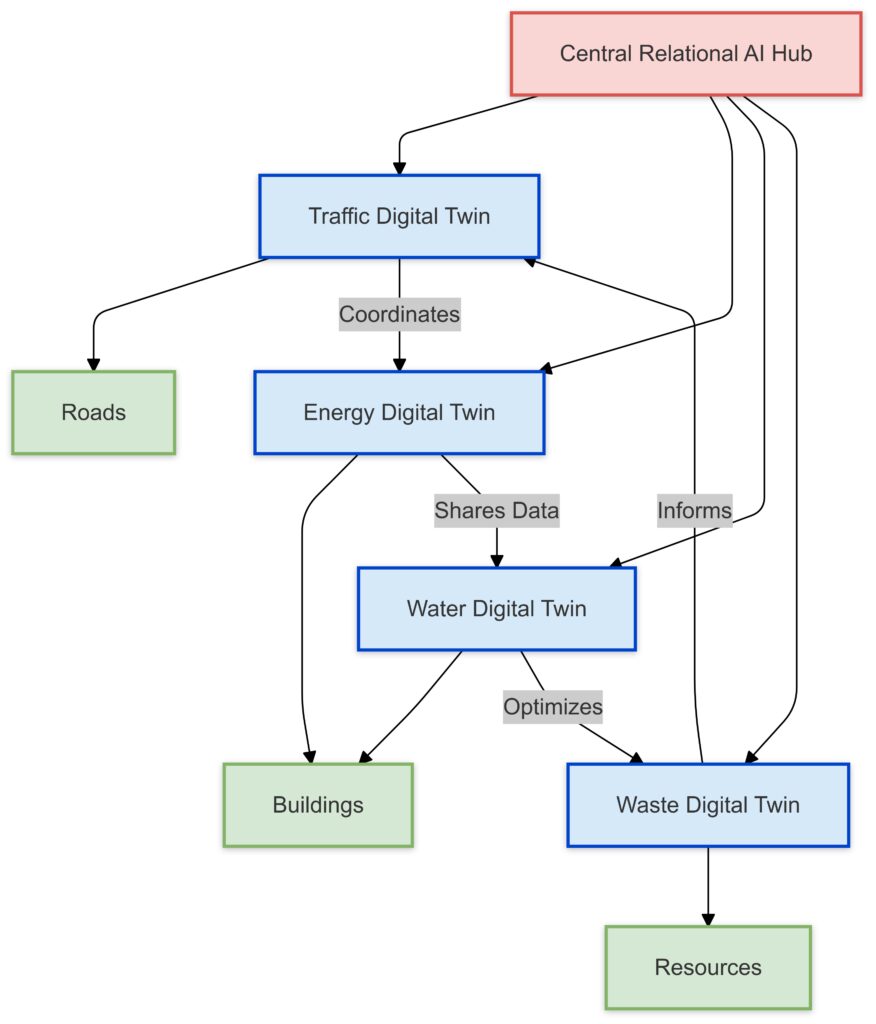
This network illustrates interconnected Digital Twins managing various systems in a smart city:
Relational AI also allows the creation of multi-twin ecosystems, where multiple Digital Twins interact. These networks are especially useful in:
- Smart cities: Traffic and energy systems interact to balance peak loads.
- Supply chains: Manufacturers, distributors, and logistics providers share synchronized simulations to optimize operations.
- Healthcare systems: Patient-level twins interact with hospital infrastructure twins for efficient resource allocation.
Such ecosystems are transforming industries by fostering collaboration and system-wide optimization.
Advanced Simulation Use Cases: A Closer Look
Energy Grid Stability and Optimization
With renewable energy sources, grid management has become non-linear and unpredictable. Digital Twins simulate demand, supply, and weather patterns to stabilize grids. Relational AI handles the complexity by:
- Mapping relationships between energy sources, substations, and consumption points.
- Simulating outages and suggesting optimal mitigation strategies.
- Predicting future energy needs based on historical and real-time data.
This ensures reliable energy delivery and reduces downtime.
Smart Infrastructure and Sustainability
Modern infrastructure Digital Twins incorporate:
- Structural monitoring (bridges, buildings).
- Environmental impact models (water usage, emissions).
- User interaction data (traffic, occupancy rates).
Relational AI helps align these layers, delivering actionable insights for sustainable development. For example, cities like Singapore are using this combination to reduce emissions, optimize urban space, and improve resource allocation.
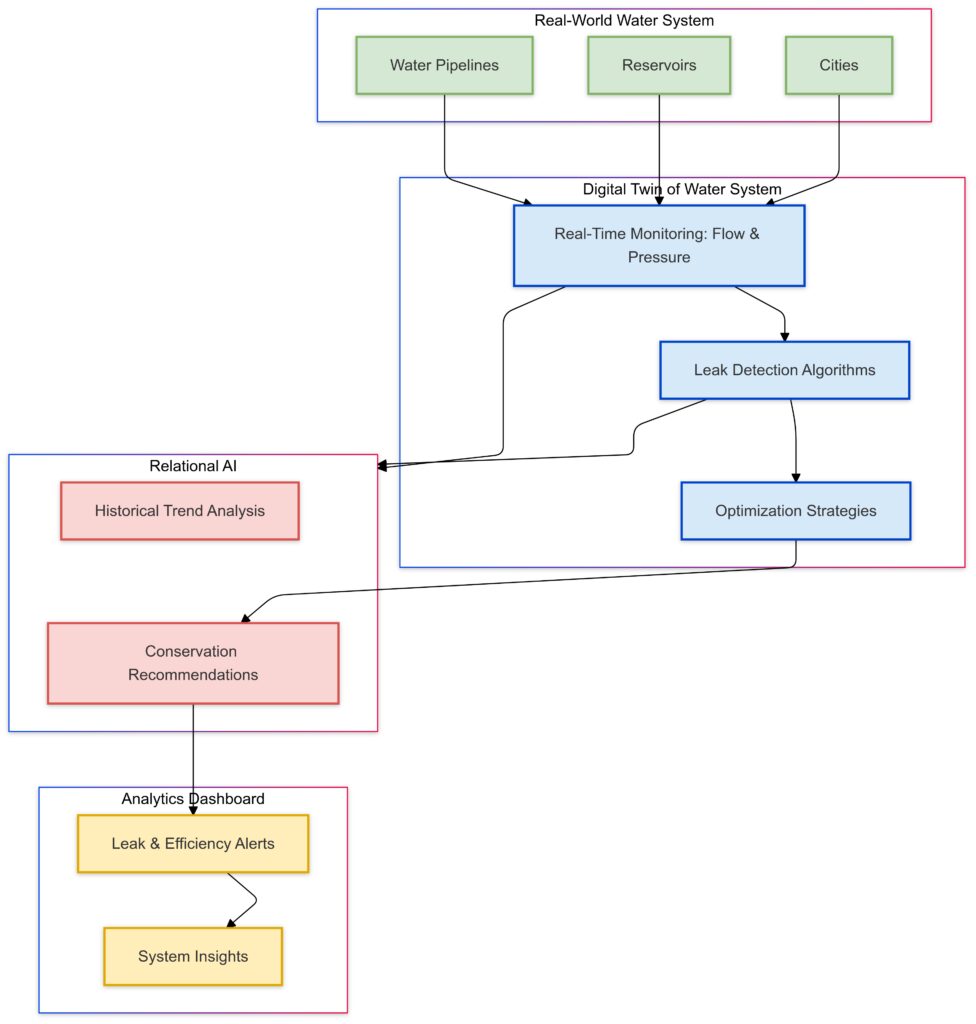
How It Works:
Actionable Outputs: Conservation strategies and alerts are displayed on the dashboard for decision-making.
Data Flow: Real-world systems feed data into the Digital Twin for analysis.
AI Integration: Relational AI enhances insights by connecting historical trends with real-time data.
Manufacturing: Digital Twins for Full Lifecycle Management
Digital Twins are no longer limited to production lines; they now cover the entire lifecycle of a product.
- Design Phase: AI simulates stress tests and user conditions.
- Production Phase: Twins optimize factory workflows.
- Operational Phase: Real-time monitoring ensures the product operates efficiently.
- End-of-life Phase: Insights inform recycling and reuse strategies.
Relational AI connects these lifecycle stages seamlessly, ensuring continuous improvement and reducing waste.
Pushing Boundaries: Predictive and Prescriptive Analytics
Predictive Capabilities Powered by Relational AI
Relational AI doesn’t just analyze historical patterns—it identifies trends that signal future outcomes. By integrating predictive models with Digital Twins, businesses can:
- Forecast operational bottlenecks before they occur.
- Simulate disaster response plans, minimizing risks.
- Plan for demand spikes or resource shortages.
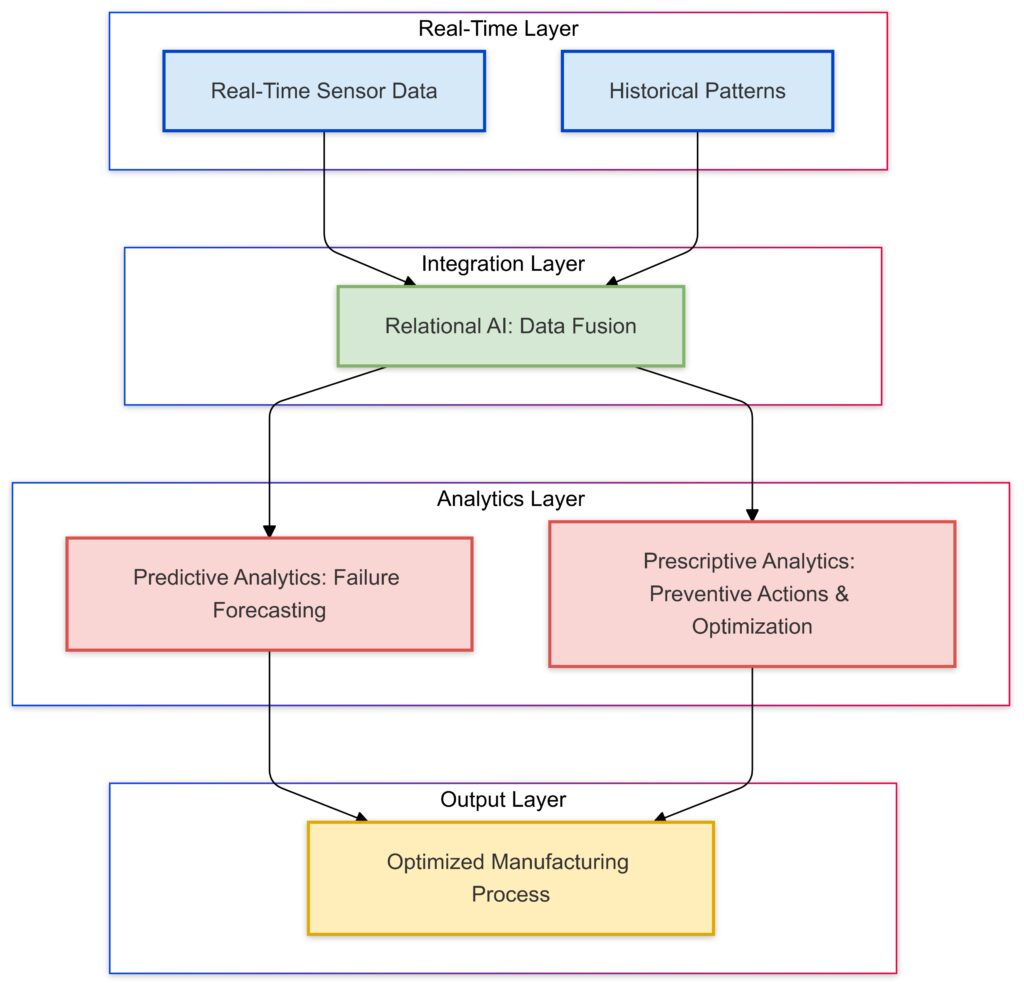
Key Features:
Prescriptive Analytics focuses on actionable solutions.
Data Flow: Arrows represent the integration and progression of data through each layer.
Contrasting Analytics:
Predictive Analytics focuses on identifying future issues.
Prescriptive Analytics: Recommendations in Real Time
Beyond prediction, prescriptive analytics leverages simulations to recommend specific actions. For instance:
- Factories: Adjust production schedules based on real-time market demand.
- Transportation networks: Optimize public transport schedules during major events or disruptions.
- Healthcare: Allocate medical resources to critical areas during pandemics.
This capability allows businesses to act with precision and confidence, ensuring optimal outcomes.
Challenges and Emerging Solutions
Data Privacy and Security
As systems grow more interconnected, privacy risks emerge. Relational AI mitigates these concerns by supporting:
- Granular data permissions.
- Secure, federated models that allow sharing insights without exposing sensitive information.
High Computational Demands
Real-time simulations are computationally expensive, especially at scale. Emerging technologies, such as edge computing and distributed AI systems, alleviate these issues by processing data closer to its source. This ensures low latency without sacrificing accuracy.
Integration Complexity
Building multi-twin ecosystems demands compatibility across platforms. Open standards and APIs are enabling smoother integrations, allowing Relational AI to connect disparate systems effortlessly.
The Road Ahead: Next-Generation Simulations
The Role of Generative AI
Generative AI could augment Digital Twins, allowing them to create adaptive strategies on the fly. This next level of intelligence could:
- Generate alternative designs or operational workflows.
- Model scenarios with minimal historical data.
- Enable self-healing systems where Digital Twins autonomously resolve issues.
Autonomous Digital Twins
Imagine Digital Twins that don’t just simulate but act autonomously. By leveraging Relational AI, these systems could:
- Self-optimize to reduce energy consumption.
- Automatically coordinate with other Digital Twins for shared goals.
- Learn from new environments without manual intervention.
Such autonomy will drive the next industrial revolution.
Conclusion:
By combining the reasoning power of Relational AI with the real-time adaptability of Digital Twins, industries are creating smarter, more efficient simulations. These technologies are pushing the boundaries of what’s possible, unlocking innovations in sustainability, efficiency, and resilience across the globe. The future of simulations is here, and it’s as dynamic as the world it models.
FAQs
Are Relational AI and Digital Twins scalable?
Yes, both are inherently scalable, capable of managing small systems or massive, interconnected networks.
For instance, a smart grid Digital Twin powered by Relational AI can scale from managing a single city’s energy needs to modeling national power networks, maintaining performance and accuracy regardless of size.
How secure are systems using Relational AI and Digital Twins?
Security is a key focus. Relational AI incorporates granular data permissions and encryption to protect sensitive information.
For example, in healthcare, patient Digital Twins can safely interact with hospital systems while ensuring individual privacy, thanks to secure, federated data sharing frameworks.
Can multiple Digital Twins work together?
Yes, Relational AI enables multi-twin ecosystems, where different twins share data and insights to optimize larger systems.
For example, in smart cities, traffic and energy twins can work together: traffic twins reduce congestion during peak hours while energy twins optimize grid usage based on vehicle charging patterns. This coordination enhances efficiency across the board.
What makes Relational AI different from other AI systems?
Relational AI specializes in handling structured and interconnected data, unlike traditional AI, which primarily focuses on unstructured data such as images or text.
For instance, in a supply chain network, Relational AI connects data points like inventory levels, transportation routes, and demand forecasts. This approach allows simulations to uncover dependencies and optimize outcomes that would be too complex for standard AI systems to handle.
How do Digital Twins adapt to changes in real-world systems?
Digital Twins adapt by leveraging real-time data streams and AI-driven predictions.
For example, a wind turbine Digital Twin constantly receives sensor data about wind speed, blade wear, and power output. Relational AI processes this data to predict optimal performance settings or flag potential maintenance needs before issues occur.
Can Digital Twins predict the future?
Digital Twins don’t predict the future on their own but, when combined with Relational AI, they become powerful tools for predictive analytics.
Take a manufacturing plant: a Digital Twin equipped with AI analyzes historical production patterns and real-time conditions to forecast when a machine is likely to fail. This lets companies schedule maintenance proactively, avoiding costly downtime.
How are Digital Twins used in sustainability efforts?
Digital Twins contribute to sustainability by modeling and optimizing resource usage, energy consumption, and environmental impact.
For example, water utility companies use Digital Twins to monitor pipe networks, reducing water loss from leaks. Relational AI enhances this by identifying high-risk areas and recommending where to focus repairs, saving water and reducing costs.
Can small businesses benefit from Digital Twins and Relational AI?
Yes, these technologies are increasingly accessible to small and medium businesses (SMBs) through cloud-based platforms.
For example, a small manufacturing firm could use a Digital Twin to monitor its machinery and detect inefficiencies. Relational AI enhances this by analyzing historical data and offering actionable insights, allowing SMBs to compete with larger enterprises.
How are Digital Twins and Relational AI used in logistics?
In logistics, these technologies streamline operations by modeling supply chains and predicting disruptions.
For instance, a global shipping company might use Digital Twins to track weather patterns, port delays, and vehicle conditions. Relational AI connects these factors, enabling real-time decisions like rerouting shipments to avoid bottlenecks or prioritizing high-demand items.
What are the limitations of Digital Twins without AI?
Without AI, Digital Twins lack the ability to process and analyze data autonomously, reducing their usefulness in complex scenarios.
For example, a building Digital Twin without AI can report on current conditions, like room temperatures or energy usage. But with AI, it can predict energy demand spikes, optimize HVAC settings, or simulate emergency evacuation plans.
Are there industries where Digital Twins and Relational AI are underutilized?
While adoption is growing, some industries—such as agriculture—are only beginning to explore these technologies.
For example, a farm Digital Twin could simulate soil conditions, crop growth patterns, and irrigation needs. Relational AI could then analyze weather forecasts and market trends to recommend planting schedules, enhancing both yield and profitability.
How do Digital Twins handle incomplete or inaccurate data?
Relational AI compensates for incomplete or inaccurate data by using rule-based reasoning and filling gaps with contextual knowledge.
For instance, if a power grid Digital Twin receives inconsistent sensor readings, Relational AI might cross-reference historical trends to estimate missing data. This ensures the simulation remains as accurate and reliable as possible.
How do these technologies help with disaster management?
In disaster scenarios, Digital Twins powered by Relational AI can simulate response plans and recommend optimal strategies.
For example, during a hurricane, a city’s Digital Twin might predict which areas will flood. Relational AI can then model evacuation routes and allocate resources like emergency personnel and supplies, ensuring a faster, more effective response.
Can Relational AI help manage multiple Digital Twins across a company?
Yes, Relational AI enables businesses to manage multi-twin ecosystems effectively by unifying data from various sources into a cohesive system.
For instance, a smart factory might have separate twins for robotics, energy consumption, and supply logistics. Relational AI integrates these twins, creating a holistic view of the factory’s operations and identifying opportunities for efficiency improvements across the board.
How do Digital Twins and Relational AI support predictive maintenance?
These technologies predict equipment failure by analyzing real-time data alongside historical trends and operational parameters.
For example, in wind farms, sensor data from turbines is fed into Digital Twins. Relational AI detects subtle changes in vibration or energy output, signaling potential failures before they escalate. This reduces downtime and ensures steady energy production.
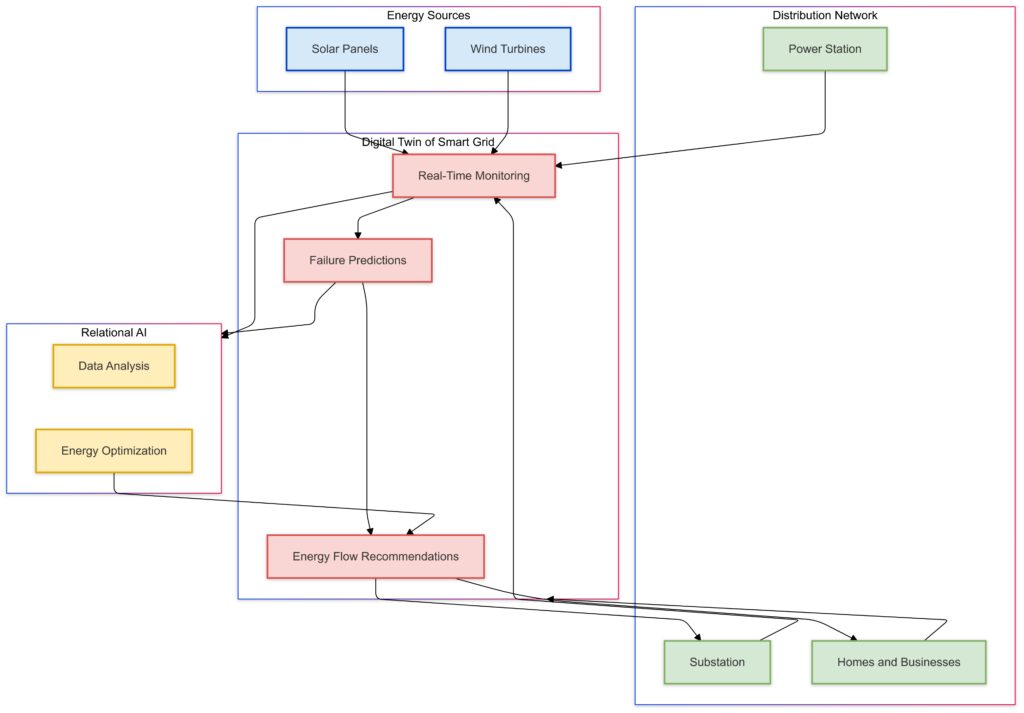
Components:
Energy Sources:
Solar Panels and Wind Turbines provide renewable energy inputs.
Real-time data on generation levels is sent to the Digital Twin.
Distribution Network:
Power Stations: Manage central energy generation.
Substations: Distribute energy to local areas.
Homes and Businesses: End-users of electricity.
Digital Twin:
Real-Time Monitoring: Tracks energy inputs, outputs, and system performance.
Failure Predictions: Identifies potential equipment issues before they occur.
Energy Flow Recommendations: Suggests rerouting power to prevent outages.
Relational AI:
Data Analysis: Processes real-time and historical data for deeper insights.
Optimization: Recommends system-wide adjustments to maximize efficiency.
Features:
Feedback Loops: Homes send consumption data back to the Digital Twin for continuous optimization.
Predictive Insights: Relational AI forecasts failures, enabling preemptive maintenance.
Dynamic Rerouting: Real-time adjustments to energy flows ensure reliable delivery.
Can Digital Twins simulate human behavior?
Yes, Digital Twins can model and simulate human behavior in specific environments, especially when powered by AI.
For instance, in retail stores, Digital Twins track foot traffic and customer interactions. Relational AI processes this data to optimize store layouts, predict purchasing trends, and improve customer experiences.
How do Digital Twins help in infrastructure development?
Digital Twins aid in planning, construction, and management of infrastructure by simulating designs and assessing performance.
For example, a bridge Digital Twin might model the effects of heavy traffic or extreme weather. Relational AI analyzes the data to recommend material improvements or changes in maintenance schedules, increasing safety and longevity.
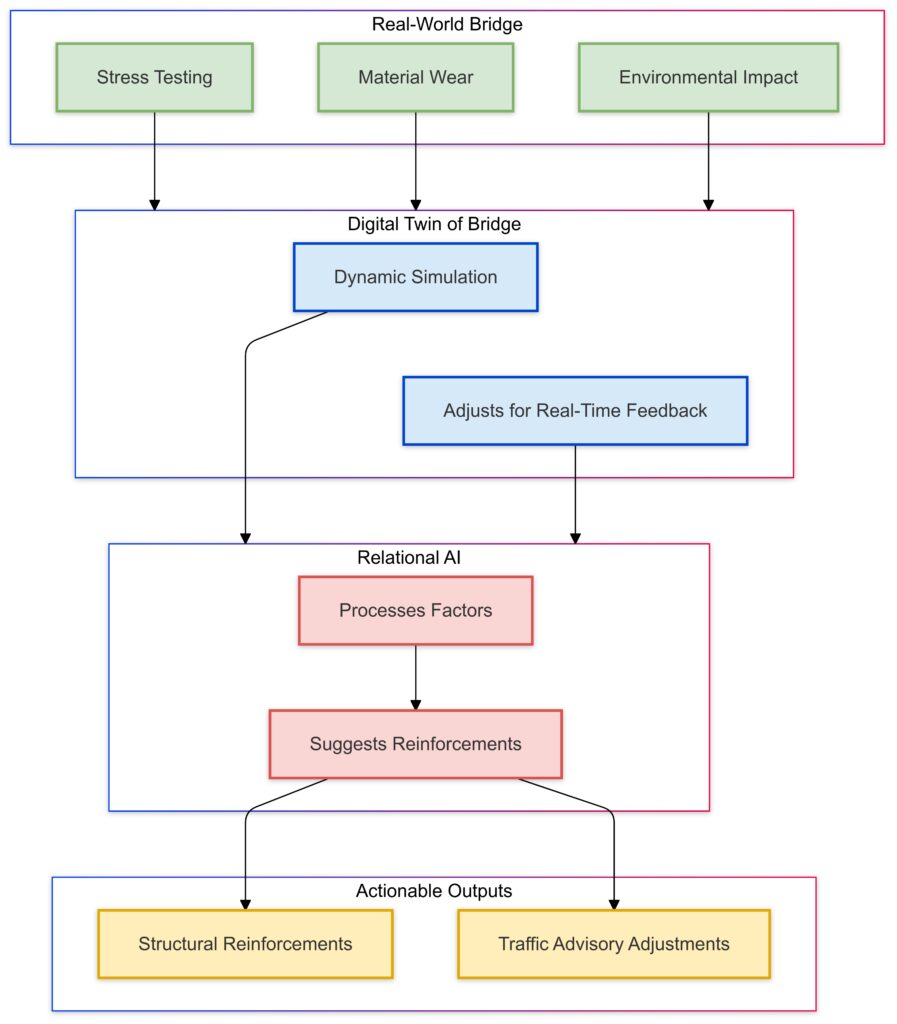
Real-World Bridge:
Stress Testing: Monitors real-time stress levels on the structure.
Material Wear: Tracks degradation of materials.
Environmental Impact: Captures effects of storms, heavy traffic, or other external factors.
Digital Twin:
Dynamic Simulation: Models the bridge’s response to real-time data.
Adjustments: Updates the simulation to reflect increasing stress levels or material fatigue.
Relational AI:
Processes Factors: Analyzes the simulation data and real-world feedback.
Suggests Reinforcements: Recommends structural improvements based on analysis.
Actionable Outputs:
Structural Reinforcements: Proposes specific reinforcement actions.
Traffic Advisory: Adjusts traffic flow to reduce stress during peak times or adverse weather.
Features:
Feedback Loops: Show how real-world data continuously refines the digital twin’s accuracy.
Integration: Relational AI connects simulation insights to practical outputs.
What role does IoT play in Digital Twins?
IoT devices provide the real-time data that keeps Digital Twins updated and relevant.
For example, in a smart city, IoT sensors monitor air quality, traffic flow, and energy usage. Relational AI integrates this data into Digital Twins, enabling the city to adapt to changing conditions—such as rerouting traffic during a pollution spike.
How do Digital Twins and Relational AI reduce environmental impact?
These technologies identify inefficiencies and optimize resource usage, minimizing environmental impact.
For instance, in water management, Digital Twins monitor water distribution systems. Relational AI identifies leaks, overuse, or contamination, enabling faster repairs and conservation efforts. This ensures sustainable resource management.
Are there specific technologies that complement Digital Twins and Relational AI?
Yes, several complementary technologies enhance their capabilities, including:
- Edge computing: Reduces latency by processing data closer to its source.
- Blockchain: Secures data integrity and facilitates trust in multi-party systems.
- Machine learning models: Add deeper insights and adaptive capabilities.
For example, combining blockchain with a supply chain Digital Twin ensures that every transaction is verifiable, enhancing transparency and trust.
How can businesses start integrating Digital Twins and Relational AI?
Businesses can begin by identifying processes with high complexity or real-time demands and deploying pilot projects to measure impact.
For instance, a logistics company might start by creating a Digital Twin of its warehouse operations. By analyzing movement patterns, inventory, and worker efficiency, Relational AI provides actionable insights. If successful, the company can scale to include transportation and supply chain twins.
What is the role of AI ethics in Digital Twins?
AI ethics are crucial to ensure responsible use of Digital Twins and Relational AI. Businesses must prioritize:
- Data privacy: Protecting sensitive information from misuse.
- Bias mitigation: Ensuring AI decisions are fair and inclusive.
- Transparency: Explaining how AI-driven insights are generated.
For example, in healthcare, a patient Digital Twin must comply with privacy regulations like HIPAA while ensuring that AI models don’t favor specific demographics over others.
Resources
Official Websites and Documentation
- RelationalAI (RelationalAI.com): Offers a comprehensive overview of relational AI systems, use cases, and technical insights into how they power real-time decision-making.
- Digital Twin Consortium (DigitalTwinConsortium.org): A global organization dedicated to advancing Digital Twin technology. Their resources include case studies, white papers, and best practices.
- IoT Analytics (IoT-Analytics.com): Provides insights into how IoT enables Digital Twins and features market reports on adoption trends and innovations.
Academic Research
- IEEE Xplore Digital Library (IEEE.org): A treasure trove of peer-reviewed papers exploring Digital Twins, Relational AI, and their applications in fields like manufacturing, healthcare, and smart cities.
- MIT Technology Review (TechnologyReview.com): Articles and research-backed insights on AI, Digital Twins, and how these technologies intersect.
Books and Publications
- Digital Twin Technologies and Smart Cities by Mohammed A. Hossain: An in-depth look at Digital Twins’ role in urban infrastructure and development.
- AI-Powered IoT for Sustainable Real-Time Systems by Arun Solanki et al.: Explores how AI and IoT work together to enable technologies like Digital Twins.
- Building Digital Twins by Michael Grieves: A foundational guide to understanding how Digital Twins are developed and used across industries.
Online Courses and Tutorials
- Coursera: Courses like AI for Everyone by Andrew Ng and Digital Twins: Industry Applications provide foundational knowledge and industry-specific use cases.
- edX: Programs such as IoT and Digital Twins for Smart Manufacturing delve into practical implementations.
- Udemy: Affordable, self-paced courses like Digital Twin Basics and Beyond focus on beginner-to-intermediate users.
Webinars and Conferences
- Digital Twin Summit: An annual event featuring industry leaders discussing the latest advancements in Digital Twin technology.
- AI World Conference: Explores the intersection of AI technologies, including Relational AI, with real-world applications like Digital Twins.
- Smart IoT London: A global stage for IoT and Digital Twin innovations, showcasing emerging trends and success stories.
Case Studies and Industry Examples
- GE Digital (GEDigital.com): Provides case studies on how their Digital Twin technology optimizes industrial operations.
- Microsoft Azure Digital Twins (Azure.Microsoft.com): Includes documentation and success stories demonstrating the platform’s capabilities.
- Siemens Digital Industries (Siemens.com): Details real-world applications of Digital Twins in manufacturing and energy sectors.
Community and Forums
- Stack Overflow: A go-to platform for technical questions about AI and Digital Twins development.
- LinkedIn Groups: Communities like “Digital Twins Experts” and “AI & Data Professionals” provide discussions, insights, and networking opportunities.
- Kaggle: Ideal for AI practitioners looking to explore datasets and challenges related to Digital Twins.